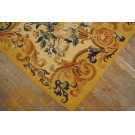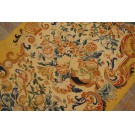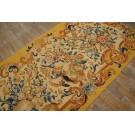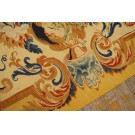Early 18th Century French Tapestry
| Stock ID: | #25095 |
| General Rug Type: | European |
| Specific Rug Type: | Tapestry |
| Circa: | 1700 |
| Ground Color: | Ivory |
| Border Color: | Yellow |
| Origin: | France |
| Material: | Wool & Silk |
| Weave: | Flat Weave |
| Shape: | Rectangle |
| Width: | 3' ( 91 cm ) |
| Length: | 6' ( 183 cm ) |
DescriptionTapestryTechnically, any neff patered fabric in which the discontinuous wefts are separated by slits, or are joined by warp sharing or weft interlocking. In this broad sense, a tapestry could be Turkish (kilim), Chinese (silk Kesi), Peruvian, Navaho. Indian (Dhurrie),etc. More precisely as an art form it refers to European wall hangings made in that technique from court and commercial workshops from Flanders to France, Italy, Germany, England and Spain, from the 14th century onward. Pictorial subjects predominate in period pieces, but some are abstract armorials. Modern tapestry designs are often by major artists and are adapted from pre-existing paintings. Traditionally, the subjects have been narrative (mythological, historical, religious) on descriptions (landscapes). The subject is vast, the price range equally so, from decorative up to highly important period works of cut. Carpets are made in tapestry weave see Aubusson. Bessarabian entries. See also Tapestry- Flemish, French, Verdure. | |
| Tearsheet Download | |














